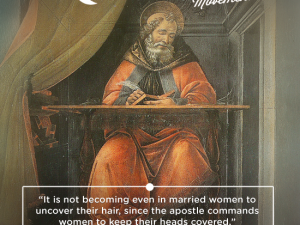What Did Saint Augustine Believe About Head Covering?

[Series introduction: This post is part of a series that examines what certain leaders in church history believed about head covering. Their arguments, choice of language and conclusions should not be misconstrued as an endorsement from us. The purpose of this series is to faithfully show what they believed about covering rather than only selectively quoting the parts we agree with.]

Augustine received a letter from his friend Possidius who was Bishop of Calama asking him numerous questions. One of those questions was should he (Calma) permit “ornaments of gold and costly dress?” Augustine told him that it shouldn’t be forbidden “except in the case of those who [are] neither [married] nor [intend] to marry.” He said this was because they “are bound to consider only how they may please God.” The rational he provided to allow those who are married to wear decorated dress was that they must “consider how they may in these things please their wives if they be husbands, their husbands if they be wives” (1 Cor 7:32-34.) So Augustine saw that looking good and attractive for your spouse was permitted. He did have one stipulation to this allowance though. He said, “with this limition, that it is not becoming even in married women to uncover their hair, since the apostle commands women to keep their heads covered.” So here we see that even though he permits married women to wear decorated dress, they are not allowed to uncover their heads. The fact that he said it was not becoming “even” in married women likely indicates that he believed single women were to cover their heads too. The fact he addressed a modern situation shows that Augustine believed that head covering was not cultural but was to be practiced in his day in Northern Africa. 1) All quotations from this paragraph are taken from “Letter 245” which can be read online here: http://www.newadvent.org/fathers/1102245.htm
In his book “On the Trinity,” Augustine says that the woman “ought to have power on [her] head, which the covering indicates.” He says that the covering refers to a “hidden sacrament” which has a “holy and pious meaning [which is] pleasing to the angels.” 2) All quotations from this paragraph are taken from “On the Trinity” (Book XII – Chapter 7) which can be read online here: http://www.newadvent.org/fathers/130112.htm
Augustine also wrote a letter where he was correcting the practice of some monks who wore their hair long. 3) All quotations from this paragraph onwards are taken from “Of the Works of Monks” which can be read online here: http://www.newadvent.org/fathers/1314.htm He said:
“Now what is more an iniquity than to wish to be obeyed by inferiors, and to refuse to obey superiors? The Apostle, I mean, not us: insomuch that they even let their hair grow long: a matter, of which he would have no disputing at all, saying, If any chooses to be contentious, we have no such custom, neither the Church of God. Now this I command; which gives us to understand that it is not cleverness of reasoning that we are to look for, but authority of one giving command to attend unto. For whereunto, I pray you, pertains this also, that people so openly against the Apostle’s precepts wear long hair? Is it that there must be in such sort vacation, that not even the barbers are to work?”
So by wearing their hair long they were “[refusing] to obey superiors” which was Paul himself. He said wearing long hair was to go “openly against the Apostle’s precepts.” He also said later that this “offend[s] and trouble[s] the church” and that the monks were “twist[ing] the manifest words of the Apostle into a wrong meaning.” He said it was a “stumbling-block before the weak for whom Christ died” and if they persisted it would lead Augustine to “grieve and mourn.” Clearly, this was no small issue to him.
How did the monks justify this practice? They had two arguments. First, to them it was a sign of humility. Since the Apostle says it’s a disgrace to wear long hair they said, “we take [this symbol of disgrace] upon ourselves, for desert4) probably means punishment of our sins.” Second, they said that since they “made themselves eunuchs for the Kingdom of God” they are “no longer men.” Augustine didn’t accept their claim to humility and said he thought they were seeking attention. He also said while there is no sex “in the inner man” (Gal 3:28) clearly bodily we still are different sexes. He points to the 1 Corinthians 11 to show these gender differences since “not veiling the head is enjoined to men” whereas “[women] are bidden to be veiled.”
So in summary, when dealing with numerous examples in his own day Augustine said that women needed to be covered and men were not to wear a covering. We also see that he passionately argued that men were not to have long hair. Throughout his writings Augustine refers to this section on headcovering as a command which needs to be obeyed.
References
- The Head Covering Movement’s New Direction: A Call for Team Members - July 11, 2025
- Is Head Covering Related to Spiritual Gifts? A Response to Barry York - July 5, 2023
- A Husband’s Authority is Limited (He is Not Pastor or King) - November 14, 2022



